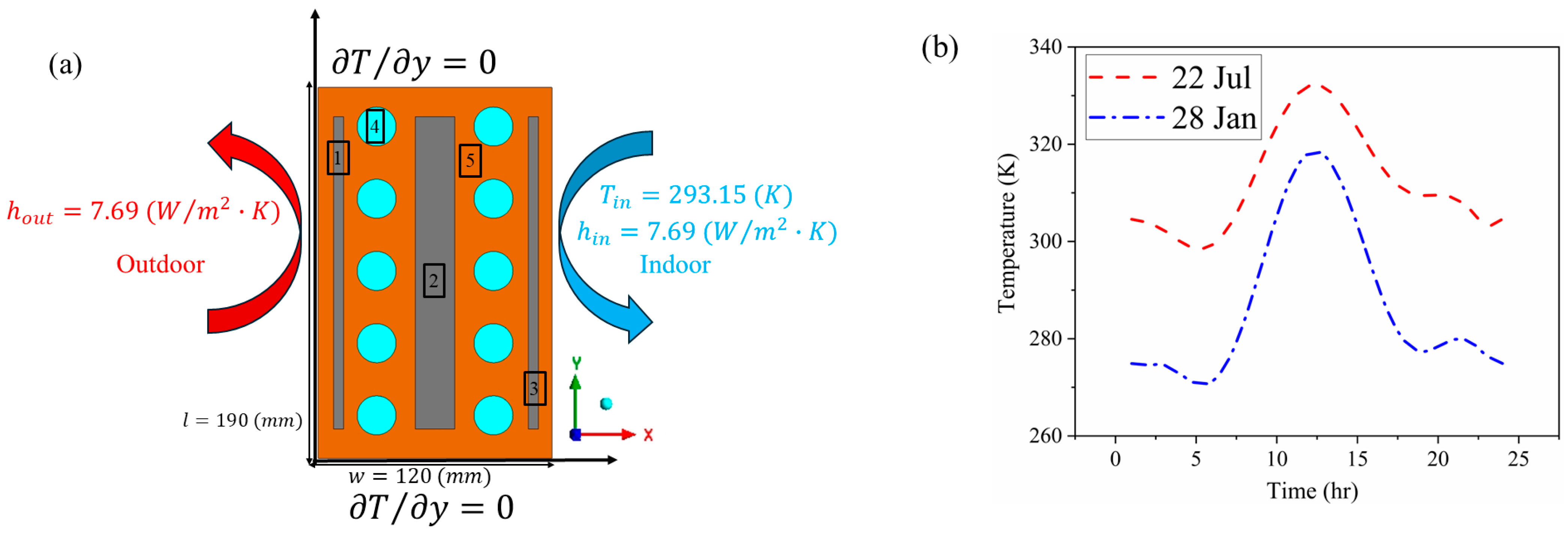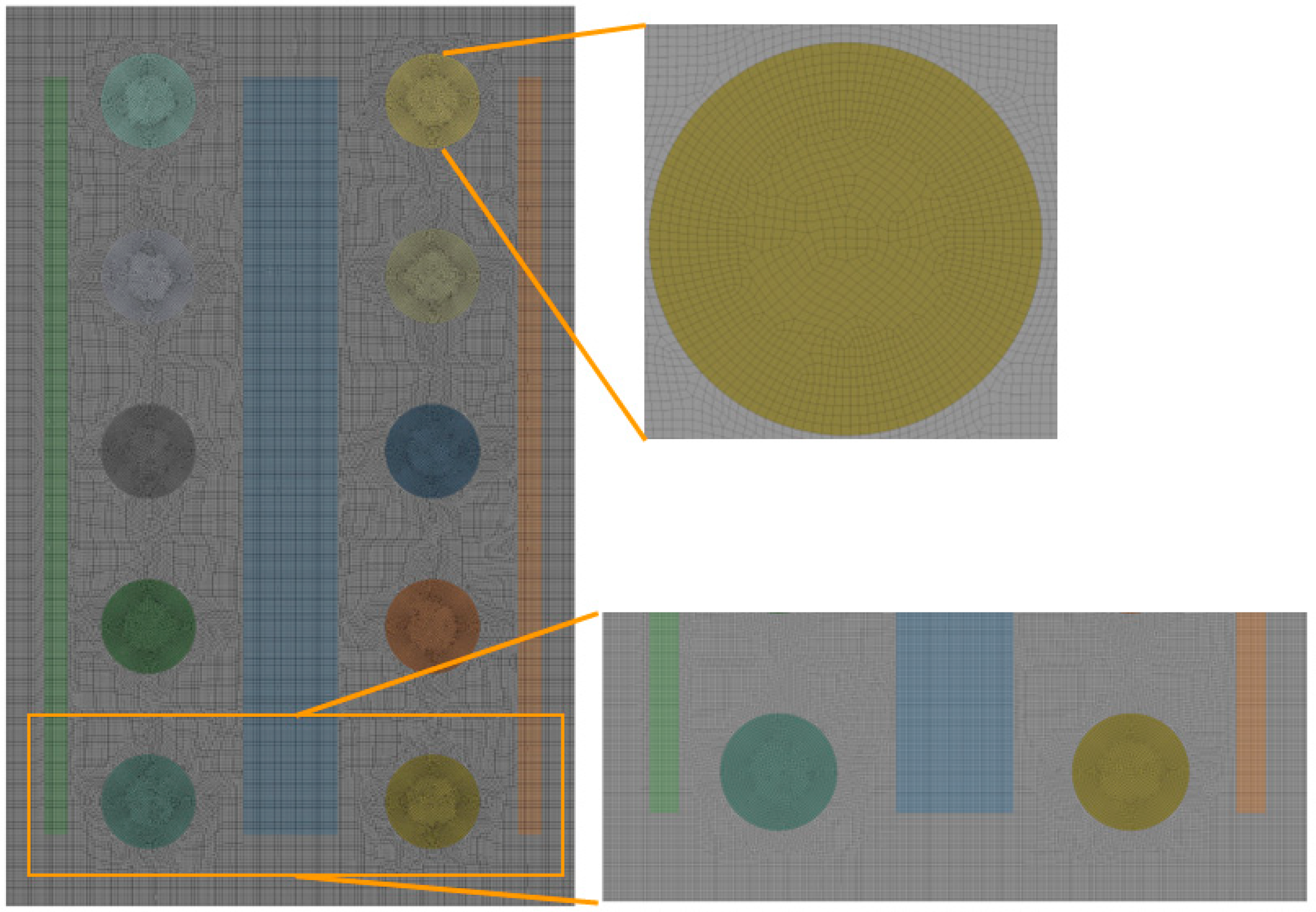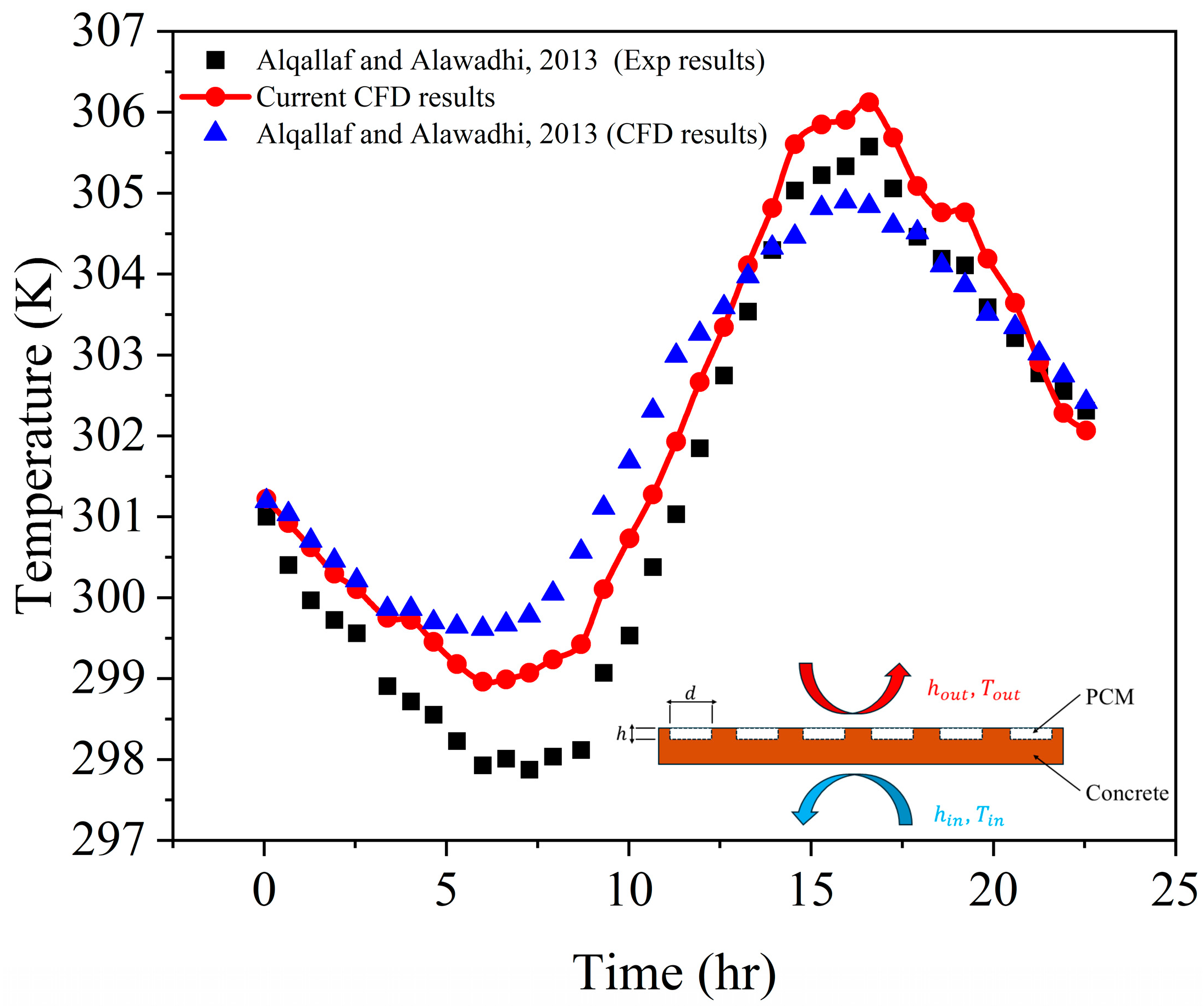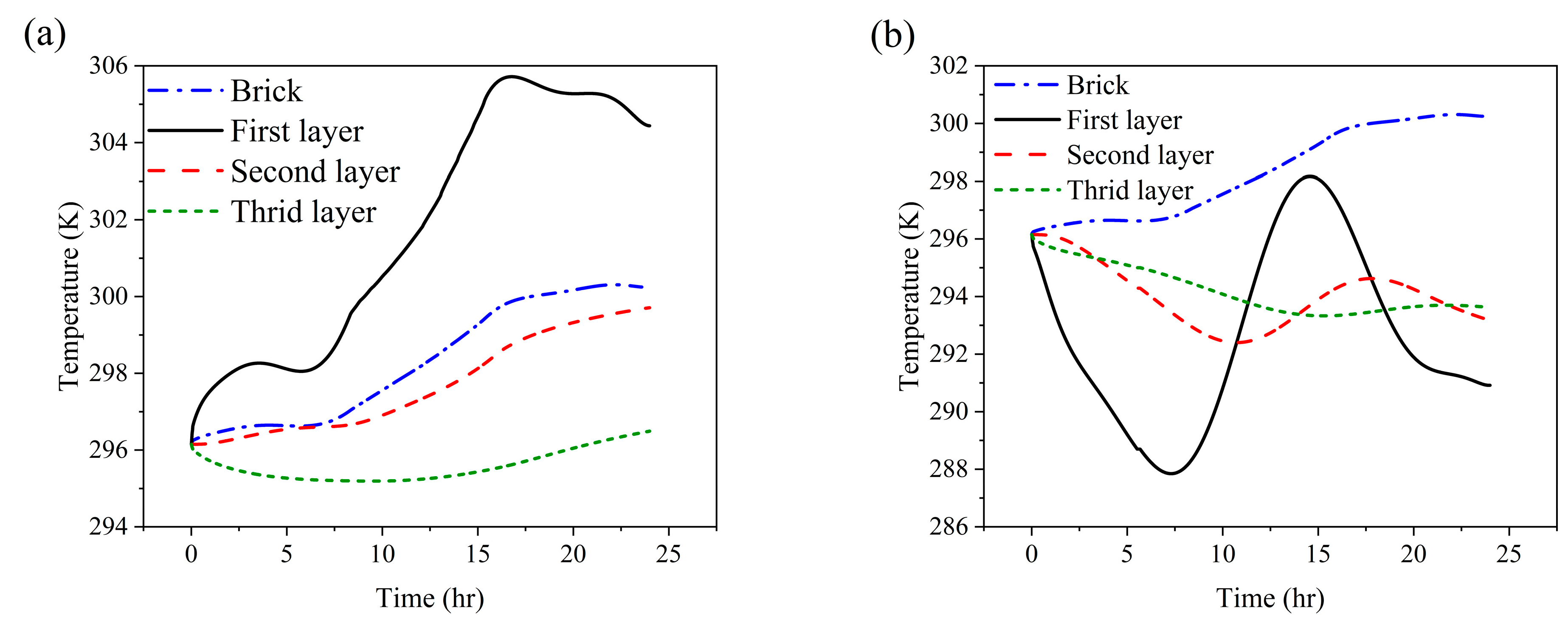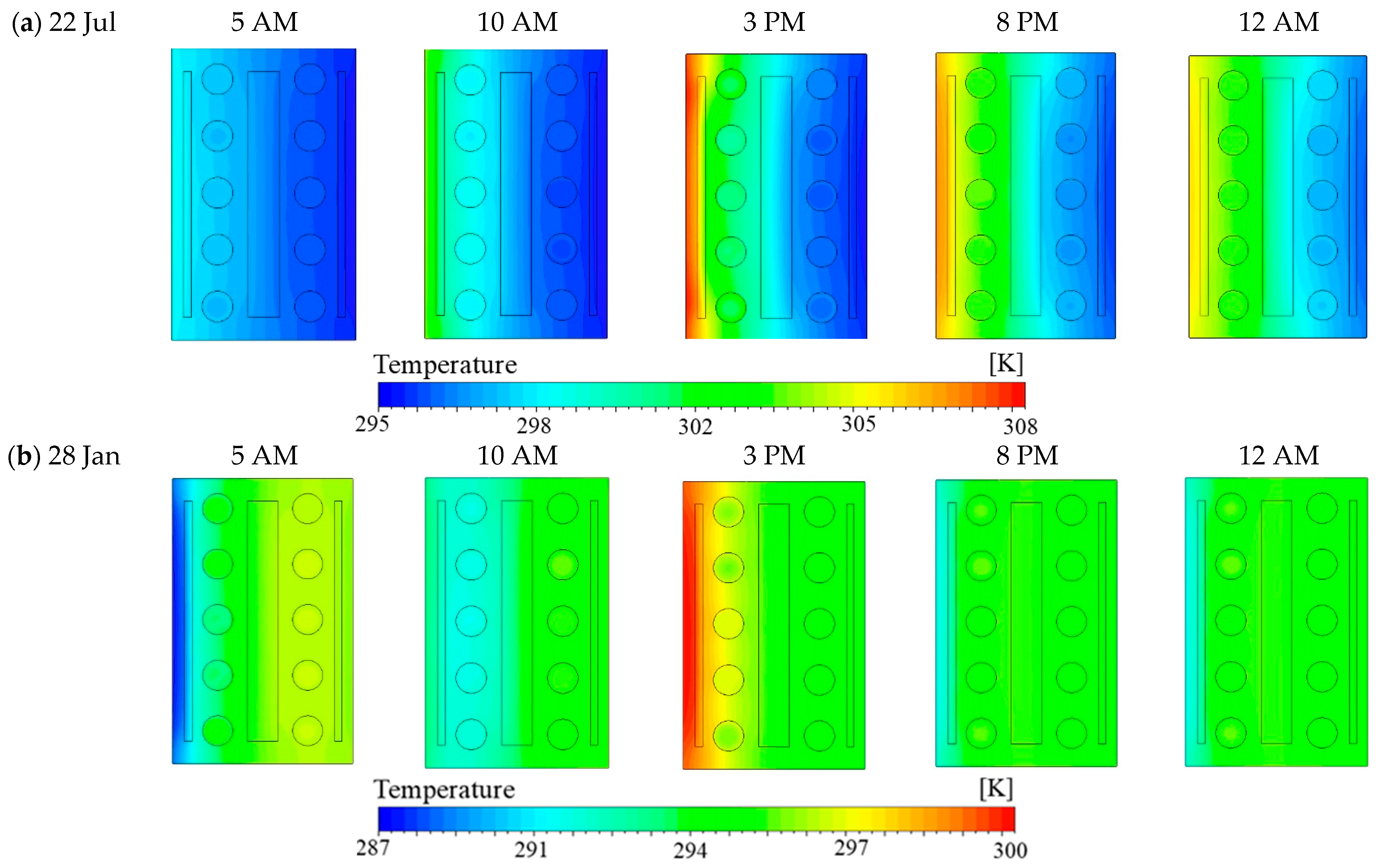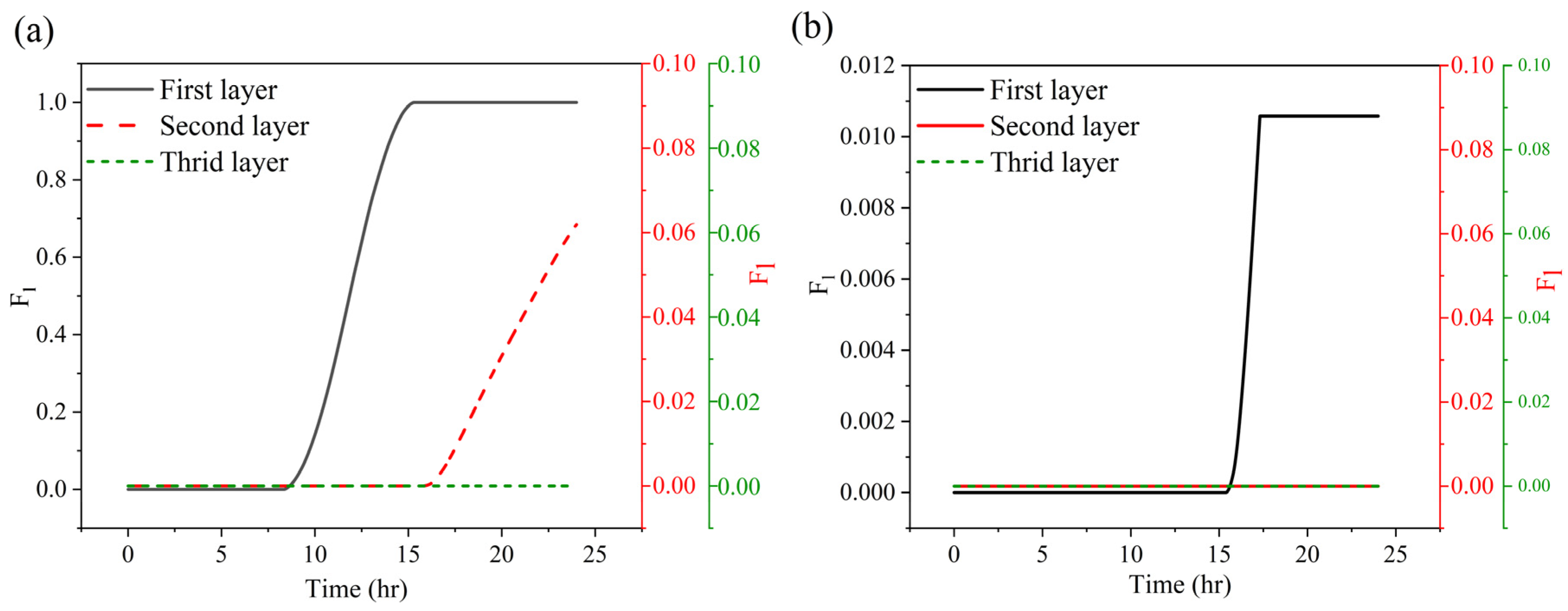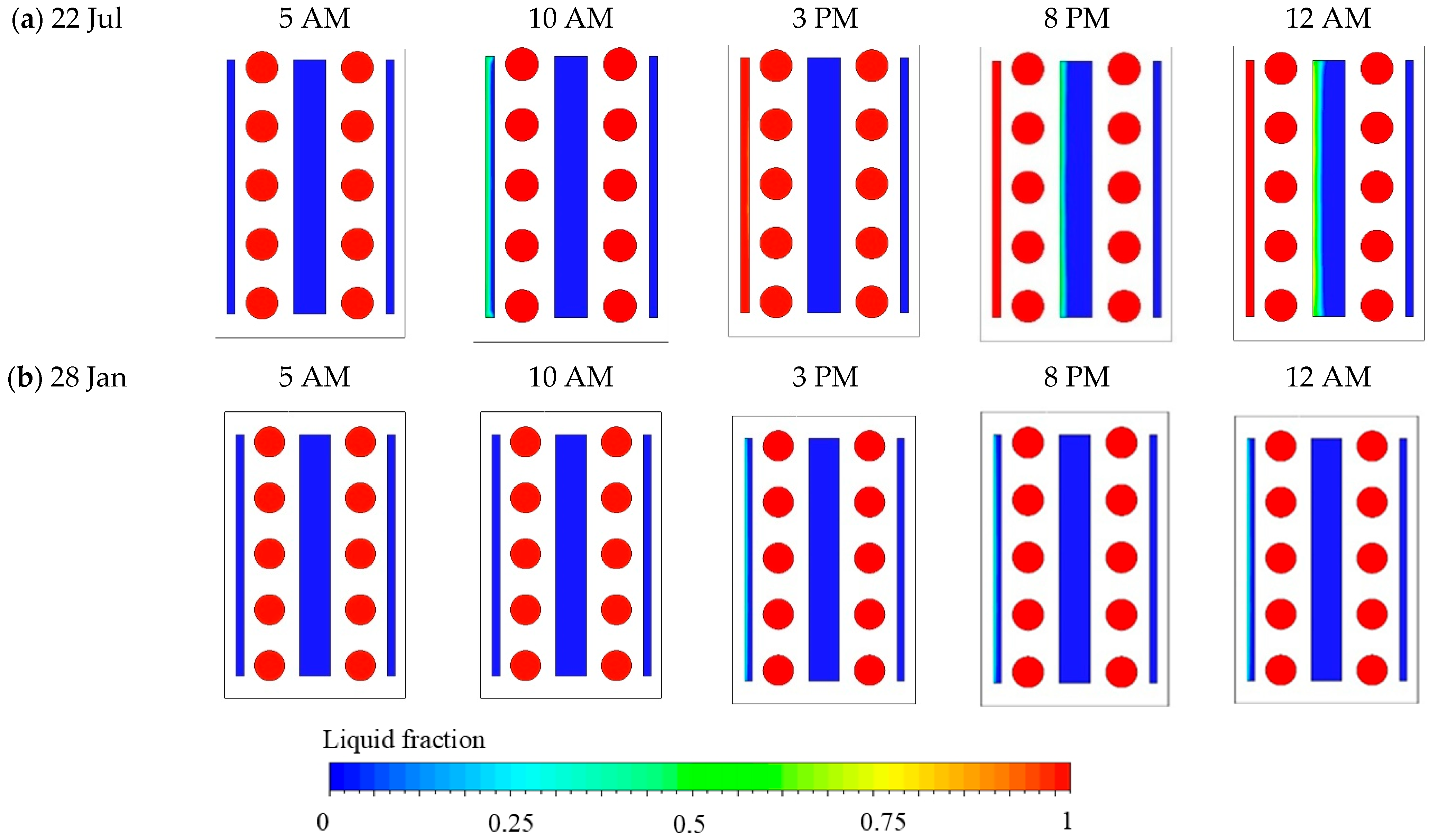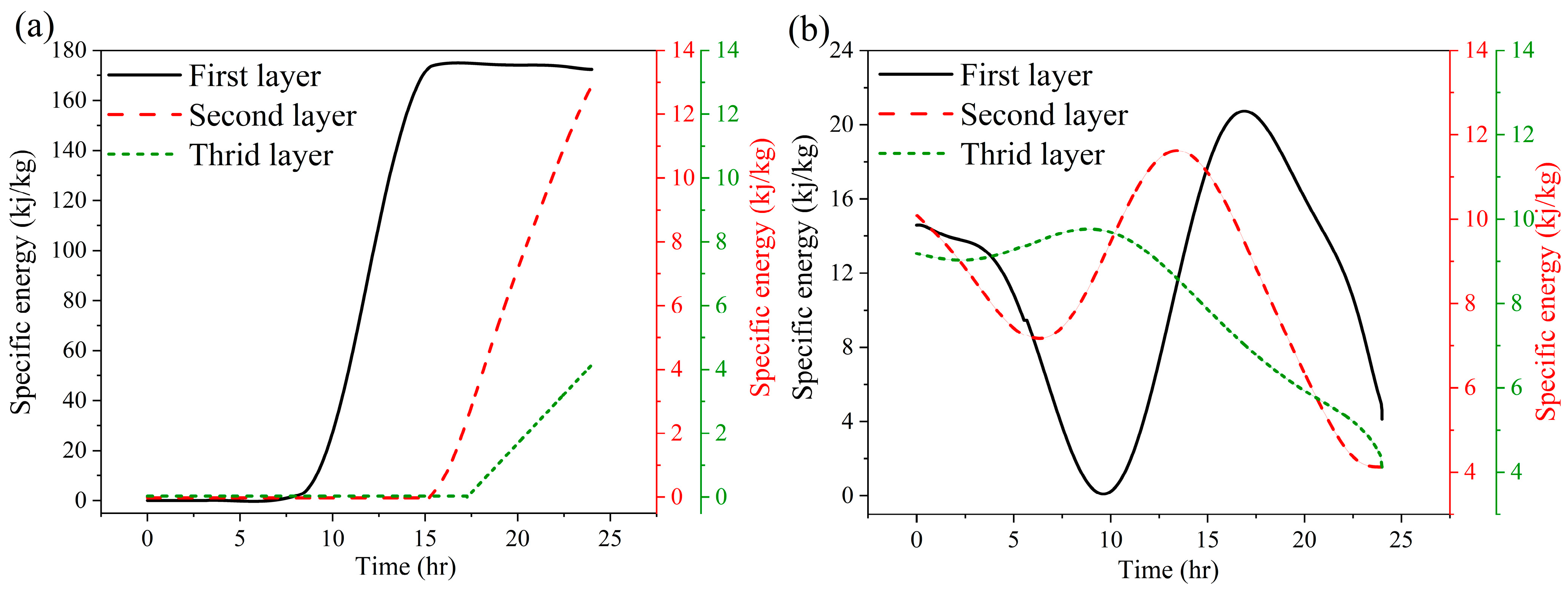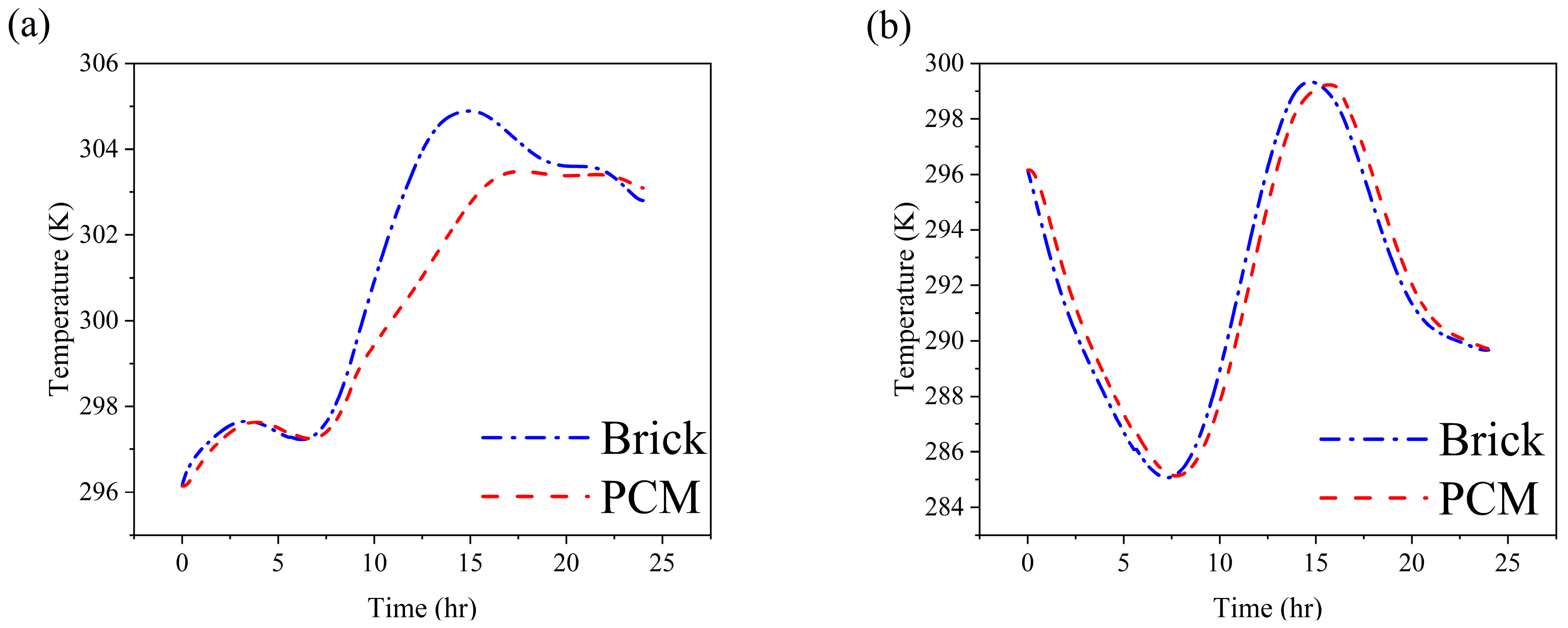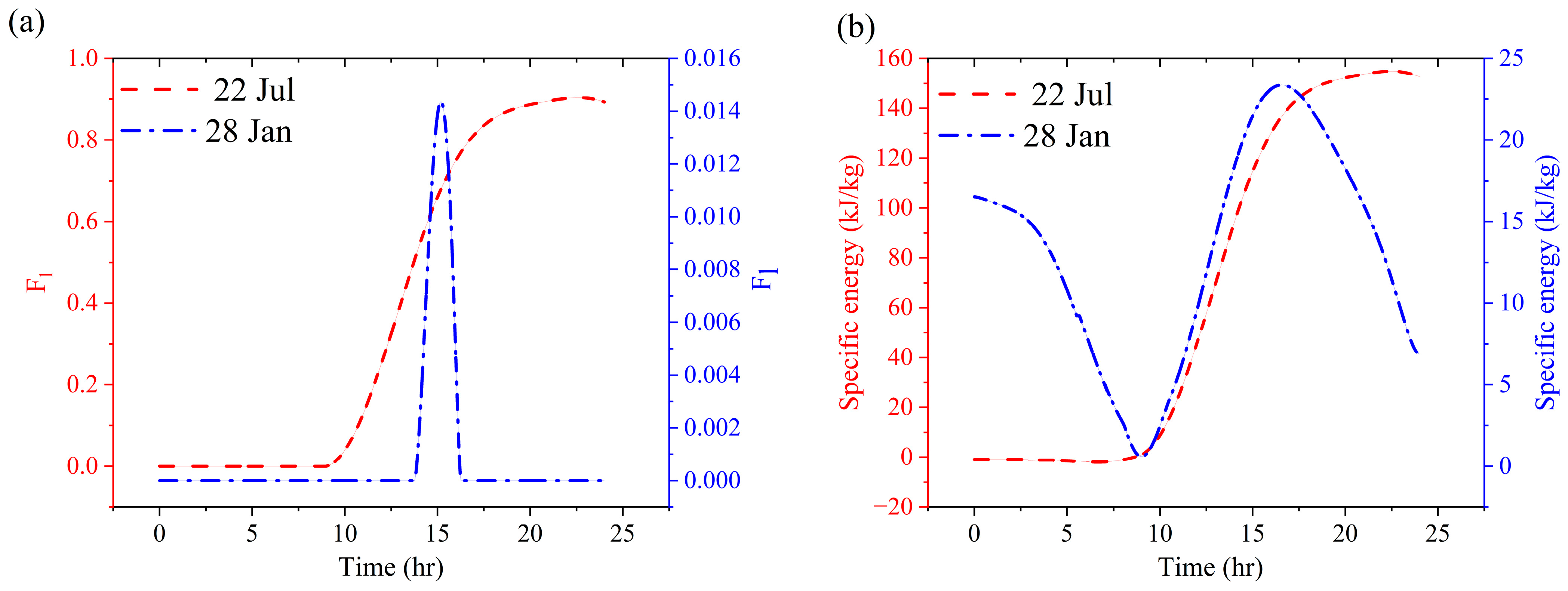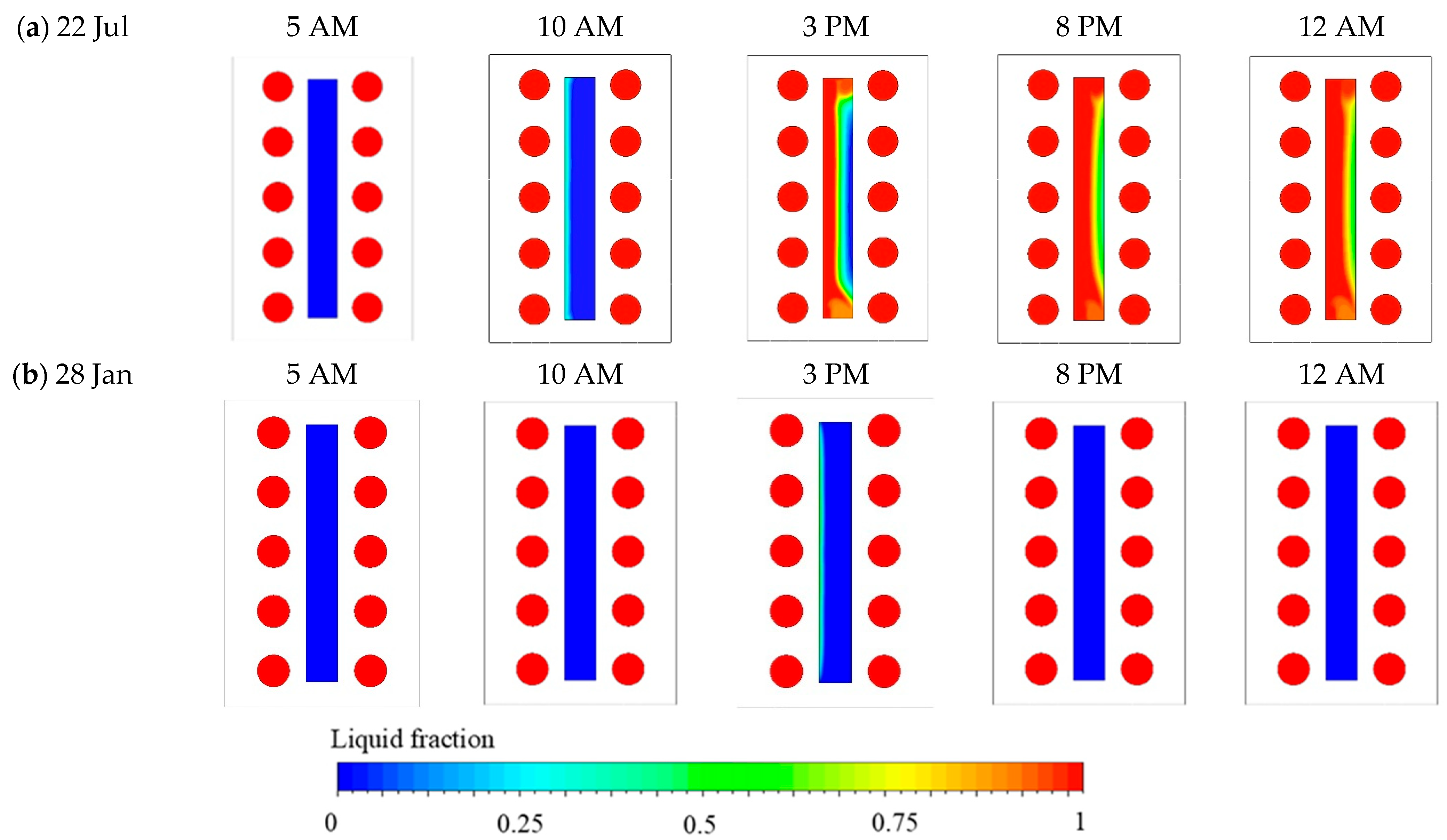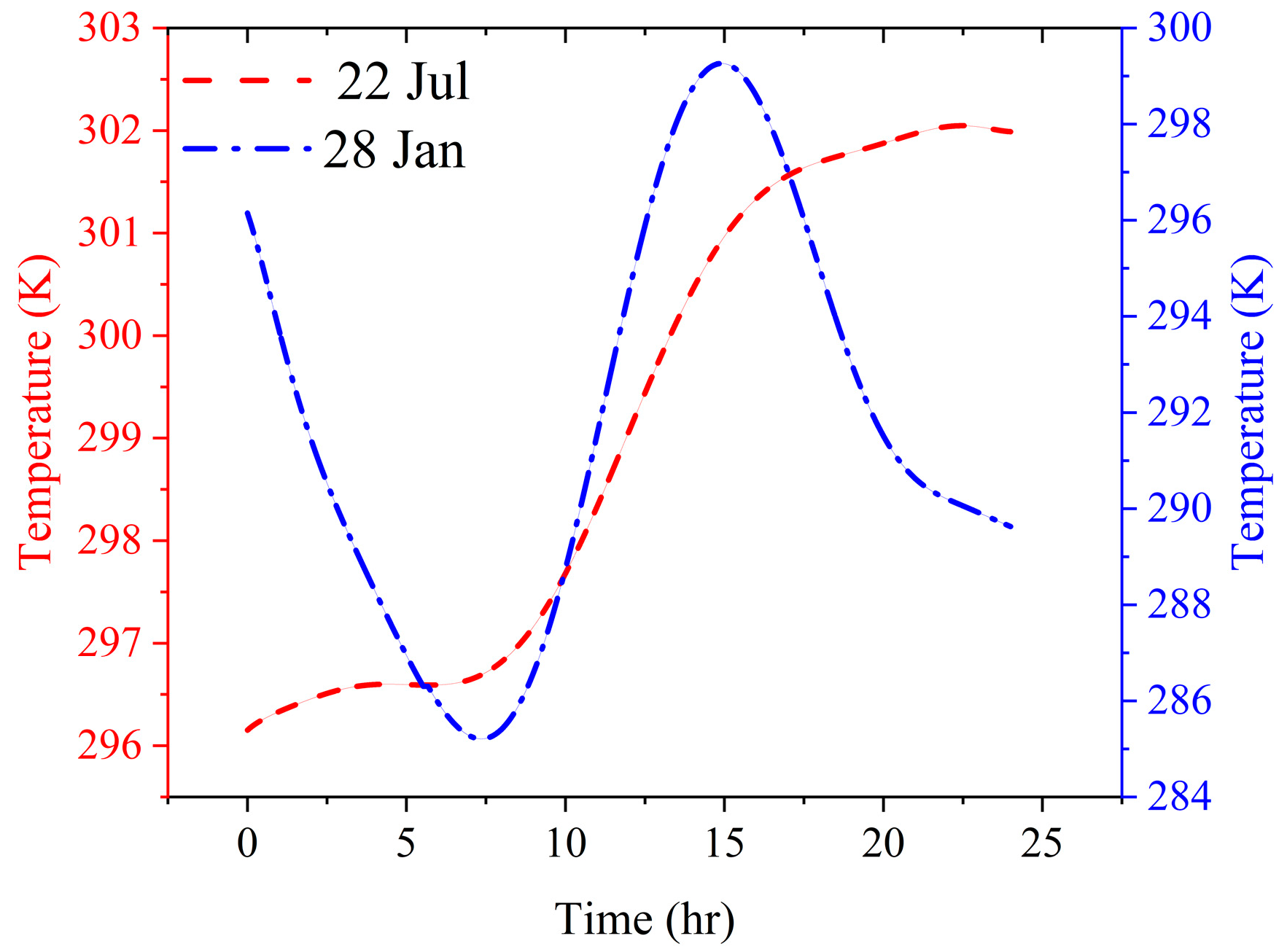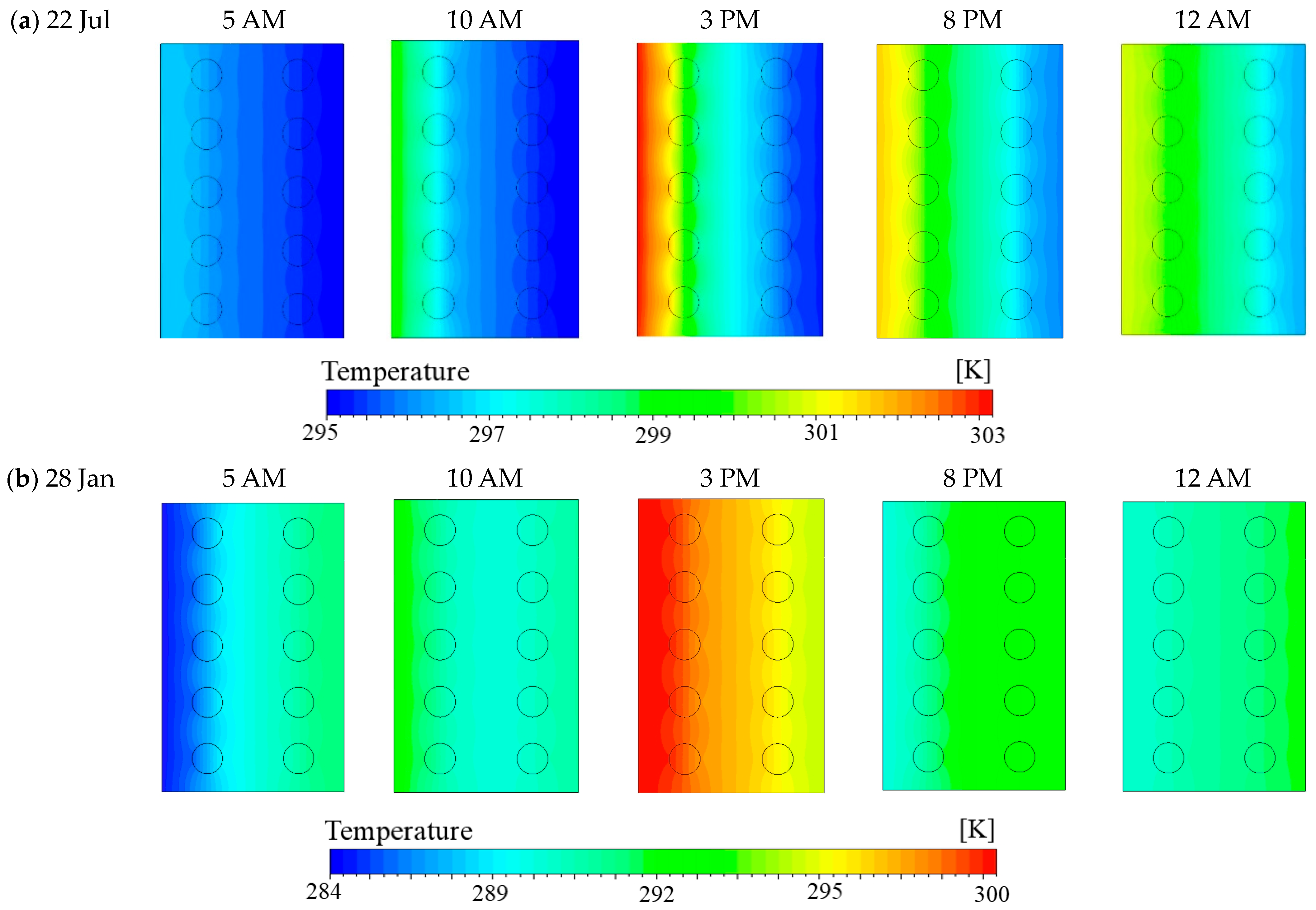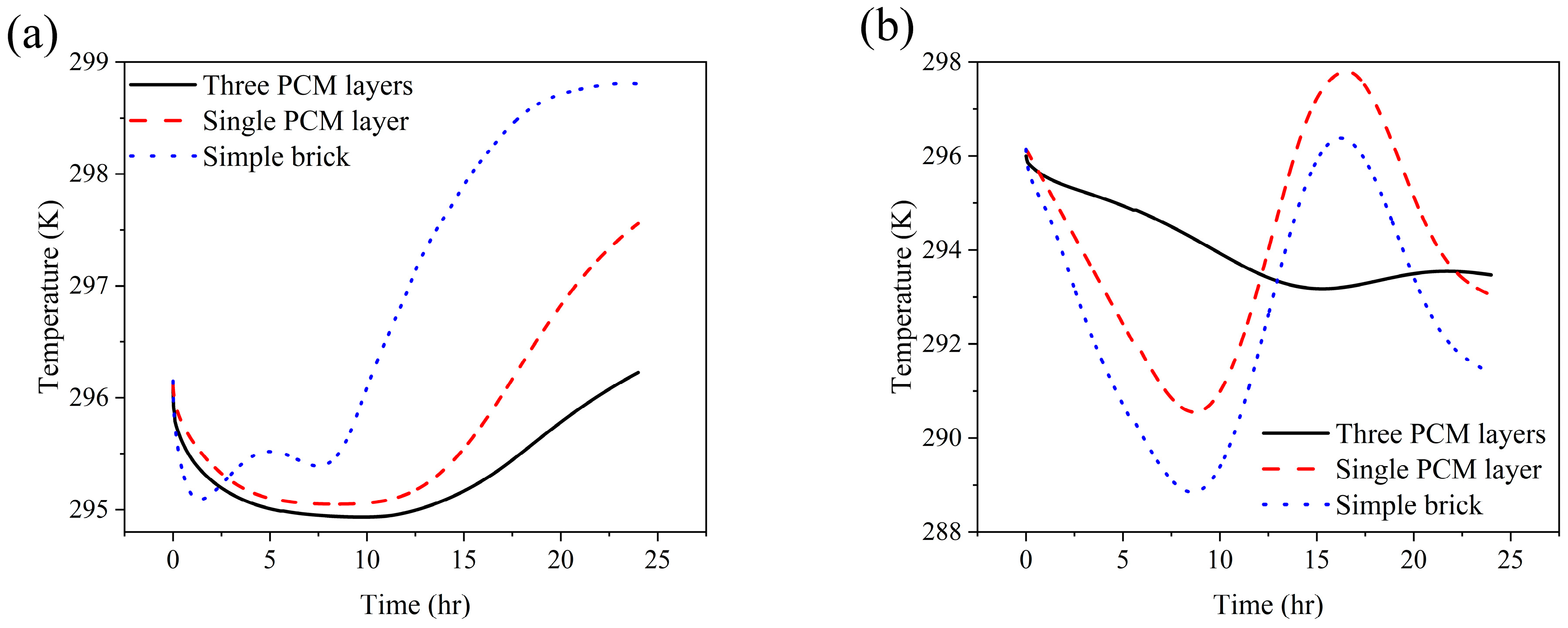This section evaluates the thermal performance of bricks incorporating encapsulated PCMs under different climatic conditions. To achieve this objective, an investigation was conducted on bricks containing either three layers or one layer of encapsulated PCMs, and the results were compared to a standard brick with no PCM layers, consisting only of air cavities.
3.1. Brick with Three Encapsulated PCM Layers
The configuration featuring three PCM layers places two thinner layers on the left and right sides of the brick—adjacent to the outdoor and indoor environments, respectively—and a thicker layer in the center. The temperature histories of these PCM layers and the brick’s solid structure under two distinct conditions, namely a hot summer day (22 July) and a cold winter day (28 January), as illustrated in
Figure 4.
Based on
Figure 4a, on the warm summer day of 22 July, the outermost PCM layer—located adjacent to the outdoor environment—exhibited the highest temperature fluctuations, reaching a peak of approximately 306 K (~33 °C) at 3 PM due to elevated outdoor temperatures and direct solar radiation. In contrast, the second and third PCM layers, positioned progressively inward, showed lower peak temperatures of approximately 299 K (~26 °C) and 296 K (~23 °C) at 3 PM and 12 AM, respectively. These findings demonstrate a sequential thermal absorption effect, with delayed heat transfer and reduced fluctuation as layers move inward. The third PCM layer, closest to the indoor space, remained relatively insulated from external conditions, primarily influenced by lower indoor temperatures. As a result, this layer experienced a gradual temperature decline until 5 AM, reflecting its role in maintaining cooler indoor conditions and highlighting the PCM’s capacity for thermal regulation and delayed heat transfer. Furthermore, the temperature peak for this layer does not occur in the afternoon (around 3 PM), as it is minimally affected by outdoor temperatures. The brick’s solid domain exhibited a smoother thermal response, with temperature fluctuations mirroring those of the second PCM layer and peaking around 300 K (~27 °C). The observed temperature gradient across the PCM layers underscores their effectiveness in impeding heat penetration and enhancing passive cooling, particularly in hot, arid climates.
Based on
Figure 4b, on the cold winter day of 28 January, the first PCM layer, exposed to the outdoor air, experienced a temperature drop to approximately 288 K (~15 °C) by 7 AM. This decrease is attributed to the low ambient temperatures typical of winter and the effects of convective heat transfer. Meanwhile, the second and third PCM layers, positioned closer to the warmer indoor environment and insulated by the outer PCM, exhibited reduced temperature fluctuations and retained higher thermal levels. This behavior helps to maintain elevated temperatures in proximity to indoor spaces during cold winter days, highlighting the latent heat storage capability of the PCM. The temperature trend observed within the brick domain remains largely stable, exhibiting minimal fluctuations. This pattern aligns with the behavior of the second and third PCM layers, which reached their peak temperature of 300 K (~27 °C) in the afternoon, specifically after 3 PM. This observation highlights the contrast between the active thermal regulation provided by PCMs and the passive thermal inertia characteristic of conventional building materials, particularly under cold winter conditions. The reduced temperature fluctuations observed in the middle and right-hand side encapsulated PCM layers, along with the steady increase in the brick’s temperature, suggest that these layers are effective in minimizing heat loss and maintaining thermal equilibrium within the brick structure.
Figure 5 illustrates the temperature distribution at different hours throughout the day and night for both a hot summer day (22 July) and a cold winter day (28 January).
According to
Figure 5a, on 22 July, the temperature gradient shows a steady increase from the outdoor environment toward the indoor area. This pattern continues until it reaches the first PCM layer, where a noticeable drop in temperature occurs, indicating the PCM’s role in resisting thermal penetration. Additionally, the temperature decreases from the center of the brick toward the rightmost (indoor-facing) section, as the indoor temperature is lower than the outdoor. This gradient remains evident throughout the day, from the leftmost (outdoor-facing) to the rightmost side. During the early morning hours (5 AM and 10 AM), the temperatures are relatively lower, with the outermost PCM layer exhibiting the coolest temperatures due to nighttime heat dissipation. By 3 PM, a significant thermal gradient emerges— both the rightmost surface and the first PCM layer reach temperatures of above 308 K (~35 °C), reflecting substantial thermal accumulation typical of summer conditions. Despite this, the first PCM layer effectively reduces heat transfer, as indicated by lower temperatures in the inner layers. At 8 PM and 12 AM, the envelope begins releasing stored heat, while internal layers remain cooler, aligning with indoor thermal conditions. This behavior illustrates the PCM’s thermal energy storage capacity and delayed heat release, demonstrating its role in preventing indoor overheating. The combined effect of thermal inertia and latent heat storage significantly enhances indoor thermal comfort and reduces cooling energy demand in hot climates.
According to
Figure 5b, the temperature gradient on 28 January, during winter conditions, reveals a distinct pattern compared to summer. This variation is attributed to lower solar intensity and prevailing cold ambient temperatures. The gradient demonstrates a steady temperature decrease from the leftmost (outdoor-facing) section to the first PCM layer, followed by a gradual increase from the left-hand side to the right-hand side, spanning from the center of the brick toward the indoor environment. An exception to this trend occurs at 3 PM, when outdoor temperatures peak. At this time, the temperature on the left side of the brick (closer to the outdoor surface) is higher than that near the rightmost (indoor-facing) side. In the early hours of the day, particularly at 5 AM and 10 AM, the external surface registers significantly lower temperatures, approximately 287 K (~14 °C), indicating notable nocturnal heat loss to the cold outdoor environment. As solar radiation intensifies by mid-afternoon (3 PM), the outer surface temperature rises reaching up to 300 K (~27 °C). Despite this, the PCM layers facilitate a relatively uniform thermal distribution across the brick by absorbing and gradually releasing heat. During the nighttime hours (8 PM and 12 AM), heat retention becomes critical, and the PCM layers effectively minimize heat loss, sustaining elevated temperatures in the inner regions adjacent to indoor spaces. This behavior highlights the dual functionality of PCM in reducing cooling loads during summer and preserving heat during winter. To examine the impact of daily temperature variations,
Figure 6 illustrates the liquid fraction evolution of the different encapsulated PCM layers on a hot summer day (22 July) and a cold winter day (28 January).
Based on
Figure 6a, during the summer scenario, the first PCM layer—which is located closest to the outdoor environment—did not commence melting until approximately 9 AM, as its temperature remained significantly below the liquidus temperature of 302 K earlier in the day (see
Figure 4a). The melting process gradually progressed, reaching its peak at around 3 PM, when the temperature of the first PCM layer was at its highest. At this point, the PCM within the first layer became fully liquefied and achieved a steady thermal state. The second phase PCM layer exhibited a delayed thermal response, initiating its phase change around 3 PM as its temperature crossed the liquefaction threshold. Meanwhile, the third PCM layer, positioned adjacent to the indoor environment, remained largely in the solid phase, indicating a notable thermal gradient across the PCM layers. This sequential melting behavior underscores the PCM’s capability to absorb and buffer external heat—particularly from the outermost layer inward—effectively delaying heat transfer into the indoor space. The fact that the third PCM layer remains predominantly solid, with a temperature lower than the adjacent brick layers, demonstrates its role in enhancing indoor thermal comfort and reducing cooling energy demand during high summer temperatures.
Figure 6b shows a significantly reduced phase transition across the PCM layers due to the lower ambient temperature of winter conditions. The first PCM layer undergoes a limited phase change, primarily between 3 PM and 4 PM, which corresponds to the period of peak outdoor temperature (refer to
Figure 4b). Even at this peak, the phase transition remains partial, and the layer only reaches a steady state well below full liquefaction. The second and third PCM layers exhibit negligible variation in their liquid fractions, indicating that they remain predominantly in a solid state throughout the day. This observation is consistent with their recorded temperatures, which do not exceed the liquidus point of the PCM. As a result, these inner PCM layers serve primarily as passive thermal masses, rather than active phase-change. The limited extent of phase transition implies that, under winter conditions, the PCM’s primary role shifts toward minimizing heat loss rather than absorbing excess heat, which subsequently enhances the thermal insulation performance of the wall system.
Figure 7 further illustrates the spatial distribution of liquid fraction contours at different times of day and night for both a hot summer day (22 July) and a cold winter day (28 January).
As indicated in
Figure 7a, the first PCM layer—positioned adjacent to the outdoor environment—exhibits partial melting as early as 10 AM, with a distinct interface emerging between the solid and liquid phases. This observation corresponds with the gradual temperature rise originating from the leftmost side of the outdoor environment to the first PCM layer. By 3 PM, when external temperatures reach their peak, the first PCM layer reveals nearly complete melting, signifying substantial thermal energy absorption. In contrast, the inner PCM layers remain predominantly in the solid phase throughout the day. Their relatively lower temperatures—compared to the outermost layer—suggest their insulating role in delaying thermal penetration and mitigating indoor overheating. Between 8 PM and 12 AM, although outdoor temperatures begin to decrease, they remain above the PCM’s liquidus temperature. Consequently, partial melting begins to occur in the second PCM layer during these evening hours. However, the third PCM layer, located nearest to the indoor environment and subjected to the lowest thermal fluctuations, remains solid, functioning solely as a thermal absorber without undergoing a phase change. This behavior exemplifies the PCM’s effectiveness in mitigating daytime thermal penetration, regulating nocturnal temperatures, and enhancing indoor cooling efficiency during hot summer days.
According to
Figure 7b, the PCM remains predominantly solid until 10 AM, with only a slight phase transition occurring near the outermost PCM layer around 3 PM. However, the system quickly stabilizes as it reaches a steady state condition. As temperatures drop in the evening, the PCM does not undergo further phase change, highlighting its role in maintaining thermal stability by minimizing excessive heat loss from the indoor environment to the colder outdoors.
Figure 8 shows the specific absorbed energy for the encapsulated PCM layers on both a hot summer day (22 July) and a cold winter day (28 January).
Based on
Figure 8a, the specific absorbed energy aligns closely with the temperature profile and liquid fraction trends discussed earlier. The first PCM layer, located adjacent to the outdoor environment on the leftmost side, demonstrates an initial increase in thermal energy absorption as sensible heat. However, this initial absorption is negligible compared to the latent thermal energy absorbed during phase transition after 9 AM. This initial negligible thermal energy absorption is due to the thermal equilibrium between the PCM and the outdoor environment, as well as the fact that its temperature remains below the PCM’s liquidus temperature until approximately 9 AM. Following this specified timeframe, a notable increase in specific energy absorption is observed, indicating the onset of latent heat storage form. This phenomenon is recognized as the second form of absorbed energy, which not only contributes to an increase in temperature but also initiates phase transitions. Therefore, the PCM phase transition and melting process are initiated, which continue until 3 PM, at which point the PCM completely melts. The specific absorbed energy reaches its peak at 170 kJ/kg, confirming the attainment of complete melting and reaching the steady-state condition. The sustained unity liquid fraction further confirms the steady-state condition and indicates that the PCM is fully melted from 3 PM to midnight. Given the estimated PCM mass of 3.26 × 10
−2 kg (as derived from its density in
Table 2), the total thermal energy absorbed by the first layer is calculated to be approximately 5.54 kJ. The second PCM layer, with a mass of 13.04 × 10
−2 kg, begins to absorb thermal energy gradually from 3 PM onwards, reflecting the delayed onset of phase transition as temperatures rise to the PCM’s liquidus point. The specific absorbed energy peaks at around 13 kJ/kg, resulting in a total absorbed energy of approximately 1.67 kJ. While this value is only about one-third of the energy absorbed by the first layer, it underscores the second layer’s crucial role in impeding inward thermal penetration. The third PCM layer, positioned closest to the indoor environment, remains mostly solid throughout the day. It displays only a slight increase in specific energy absorption around 5 PM, associated with minimal latent heat storage. Given its similar mass to the first layer, the total energy absorbed is calculated to be approximately 0.13 kJ. The significantly lower energy absorption in the second and third PCM layers reflects both thermal resistance and the time lag in heat transfer from the outer layers inward.
According to
Figure 8b, the specific absorbed energy trends during the cold winter day exhibit noticeable fluctuations, particularly during the early morning hours. These variations are most prominent in the leftmost PCM layers, which are in direct contact with the cold outdoor environment. This behavior is attributed to thermal energy dissipation to the outdoors and reflects the bidirectional nature of heat exchange between indoor and outdoor environments. The first PCM layer shows the most significant oscillations due to its direct exposure to ambient conditions. In the early morning, its specific absorbed energy decreases sharply as heat is lost to the cold surroundings. As the day progresses and outdoor temperatures increase slightly, a minor rise in specific energy is observed, corresponding to limited PCM melting in the afternoon. Based on its mass (3.26 × 10
−2 kg) and a peak specific energy of 23 kJ/kg, the maximum energy absorbed by this layer is approximately 0.75 kJ. However, this value drops to 0.16 kJ by 12 AM, which is lower than its initial energy state, indicating continuous thermal energy loss during the nighttime.
Initially, all PCM layers retain some residual thermal energy stored from the previous day, but the temperature gradient between the warmer interior and the colder exterior promotes energy dissipation over time. The second PCM layer exhibits a more stable energy profile and reduced fluctuations due to its insulation from the leftmost outdoor environment. This layer’s enhanced thermal mass effectively mitigates thermal dissipation. Given its higher mass (13.04 × 10−2 kg) and peak specific energy of 12 kJ/kg, the total absorbed energy is approximately 1.56 kJ—double that of the first layer—highlighting its effectiveness in thermal stabilization. The third PCM layer, closest to the indoor space, exhibits a muted thermal response. It registers a peak specific energy of 9 kJ/kg around 10 AM, with a total energy absorption of 0.29 kJ, given its equal mass to the first layer. This energy is approximately half that of the first layer, underscoring the third layer’s limited exposure to external thermal influence. The reduced energy absorption and lower fluctuation amplitude highlight the effectiveness of the PCM system in enhancing thermal comfort during winter by reducing heating loads and preserving internal heat through the mitigation of heat loss across the building envelope.
3.2. Brick with Single Encapsulated PCM Layer
This configuration features a single encapsulated PCM layer strategically embedded at the central part of the brick structure. The analysis focuses on the temperature history of both the PCM layer and the surrounding solid brick material under two contrasting climatic conditions, namely a hot summer day (22 July) and a cold winter day (28 January), as depicted in
Figure 9.
Figure 9a presents the averaged temperature history of the PCM and brick layers under summer conditions. The centrally embedded PCM layer exhibits a delayed and attenuated temperature response compared to the surrounding brick layers. Between 10 AM and 8 PM, the PCM reaches a maximum temperature of approximately 304 K (~31 °C) at 3 PM, whereas the brick layer peaks earlier at 1 PM with a slightly higher temperature of 305.5 K (~32 °C). Notably, this peak brick temperature exceeds that observed in the configuration with three PCM layers, emphasizing the enhanced thermal resistance provided by additional PCM layers in limiting heat penetration toward the indoor-facing side (see
Figure 4a). The observed delay and the lower peak temperature of the single PCM layer are consistent with the behavior seen in the central PCM of the three-layer configuration. As the central layer, the PCM functions as an insulator, highlighting its essential role in absorbing and storing thermal energy during periods of high outdoor temperatures. This mechanism reduces thermal transmission through the brick and contributes to improved indoor thermal comfort. In contrast,
Figure 9b illustrates the winter scenario, where both the PCM and brick layers exhibit nearly identical thermal profiles throughout the 24 h cycle. During the early morning cooling phase, when the leftmost (outdoor-facing) surface temperature drops below the initial temperature of the brick (until 9 AM), both materials experience a rapid temperature decline, reaching a minimum of approximately 285 K (~12 °C). This suggests the PCM provides limited resistance to heat loss during this period. Similarly, during the daytime heating phase leading up to 3 PM, both materials warm in tandem, with the PCM reaching a peak temperature nearly identical to that of the brick (~299 K or ~26 °C). The similar thermal response between the PCM and brick in this single-layer configuration indicates that under cold winter conditions, the PCM primarily acts as an insulator, offering minimal latent heat contribution. As a result, sensible heat storage dominates the system’s thermal performance, and the overall performance is nearly indistinguishable from that of the brick alone. This finding underscores the temperature-dependent nature of PCM functionality, where its thermal benefits diminish when ambient temperatures fall outside its phase change range.
Figure 10 further illustrates the temperature distribution for both the hot summer day (22 July) and the cold winter day (28 January), offering deeper insight into the thermal behavior across the brick–PCM configuration.
According to
Figure 10a, the temperature gradient during summer varies from approximately 296 K (~23 °C) at 5 AM to a peak of about 305 K (~32 °C) at 3 PM, with the highest temperatures observed on the brick’s leftmost (outdoor-facing) side. Notably, the thermal penetration from the outer surface to the brick’s center, particularly around the PCM layer, is significantly more pronounced in this single-layer configuration compared to the brick with three PCM layers (refer to
Figure 5). This discrepancy stems from the absence of the first PCM layer, which acts as a thermal buffer by delaying heat propagation and absorbing it via latent heat storage. Without this layer, both the brick and PCM exhibit a more rapid temperature rise throughout the day. By 8 PM and 12 AM, the system begins to release stored heat, resulting in a rapid temperature decline from the outer layers to the environment. This cooling trend is more pronounced in the single-layer configuration due to insufficient insulation and limited thermal storage capacity on the exterior side, further highlighting the role of multiple PCM layers in moderating thermal discharge. Although the single encapsulated PCM layer exhibits some thermal mass and sustains elevated temperatures compared to early morning levels, its latent heat storage capacity is limited and less effective in maintaining thermal comfort than a multi-layer PCM system.
In contrast,
Figure 10b illustrates the temperature field under winter conditions. During early morning hours, the temperature is lower on the leftmost (outdoor-facing) side than on the rightmost (indoor-facing) side due to colder external conditions. This trend continues until 5 AM. However, unlike the three-PCM-layer configuration, the temperature on the leftmost side exceeds that on the rightmost side by 10 AM, primarily due to the absence of the first PCM layer (see
Figure 5). While temperatures peak around 3 PM, they remain significantly lower than summer values, and thermal penetration is more substantial due to the lack of latent heat buffering from an external PCM layer.
Despite this, the centrally placed PCM layer still provides a modest insulating effect, maintaining a relatively stable temperature gradient across the brick. By 8 PM and 12 AM, the system reaches thermal equilibrium, though with reduced heat retention compared to summer. The absence of both the first and third PCM layers—critical for insulation and temperature regulation—significantly reduces temperature and causes intense thermal fluctuations during winter. This seasonal variation in thermal behavior underscores the phase-dependent nature of PCM. Its efficiency in energy storage and release is significantly reduced during winter due to lower ambient temperatures that inhibit complete phase transition. This analysis highlights the PCM’s strong performance in mitigating extreme temperature fluctuations during summer, while offering moderate thermal regulation under colder winter conditions.
To further evaluate the impact of daily temperature fluctuations,
Figure 11 presents the liquid fraction and specific absorbed energy of the single PCM layer on a hot summer day (22 July) and a cold winter day (28 January).
Regarding
Figure 11a, under summer conditions, the PCM undergoes a gradual phase transition beginning around 10 AM—coinciding with the onset of melting observed in the first PCM layer of the three-layer configuration. In this single-layer setup, the centrally located PCM layer directly interacts with thermal penetration due to the absence of insulating layers (see
Figure 6). As a result, the liquid fraction steadily increases throughout the day, reaching approximately 0.9 by 8 PM, indicating that steady-state conditions have been achieved. In contrast, the winter scenario reveals a sharp and limited phase transition at 3 PM, occurring only when the average temperature approaches the PCM’s liquidus point. The peak liquid fraction in this case is just 0.015, significantly lower than in the summer scenario. This discrepancy underscores the influence of ambient conditions on PCM behavior: elevated temperatures enable extended energy absorption and storage, whereas colder conditions lead to a rapid but minimal phase change. Additionally, unlike the three-layer PCM configuration—where the phase transition remains constant at a liquid fraction of zero—the liquid fraction in the single-layer PCM begins to decrease as temperatures fall, resulting in solidification. This behavior results from the absence of the first and third PCM layers that previously acted as thermal buffers. These findings underscore the importance of configuration design, illustrating that while PCM is effective in mitigating temperature fluctuations, its thermal performance is highly sensitive to climatic conditions and the extent of thermal insulation.
Based on
Figure 11b, under summer conditions, the specific energy remains relatively constant during the early hours, with only minimal sensible heat absorption and no phase transition. Subsequently, a gradual increase begins around 10 AM, corresponding to the onset of phase change, during which latent heat is absorbed. This continues until the PCM reaches a peak specific energy level of approximately 150 kJ/kg under steady-state conditions. In contrast, the winter scenario exhibits a fluctuating specific energy profile. An initial decrease is observed up to 10 AM, resulting from lower ambient temperatures, followed by a sharp increase around 3 PM, peaking at approximately 24 kJ/kg as latent heat storage is briefly absorbed during a limited phase transition.
Given the PCM mass of , the total absorbed energy in summer reaches approximately 19.56 kJ, whereas in winter, it is significantly lower at just 3.13 kJ. This disparity is directly linked to the behavior of the liquid fraction: in summer, a gradual phase transition enables sustained latent heat absorption, while in winter, the abrupt and limited phase transition limits the PCM’s energy storage potential. These findings underscore the critical role of the liquid fraction in determining the PCM’s thermal performance. The extent and duration of the phase transition largely dictate the material’s ability to regulate indoor temperature fluctuations under varying climatic conditions.
Figure 12 presents the liquid fraction contours at different times throughout the day and night for both a hot summer day (22 July) and a cold winter day (28 January).
Based on
Figure 12a, the phase transition of the PCM on a hot summer day exhibits a progressive phase transition. This process begins around 10 AM as rising temperatures initiate the shift from sensible to latent heat storage, marked by the appearance of the solid–liquid interface. By 3 PM, at peak ambient temperature, a substantial portion of the PCM undergoes melting, driven by latent heat absorption. This thermal penetration from the leftmost (outdoor-facing) to the rightmost side induces a non-uniform melting pattern, with the top and middle sections transitioning first due to buoyancy-driven natural convection effects. The liquid fraction increases gradually along the PCM’s vertical centerline, reaching its maximum extent by 8 PM and stabilizing thereafter, indicating the attainment of steady-state conditions. By 12 AM, a partially melted state is still maintained due to the stored thermal energy, demonstrating the effectiveness of PCM not only in mitigating temperature fluctuations and thermal penetration during the day but also in preventing thermal dissipation at night.
According to
Figure 12b, the PCM remains predominantly in a solid state during the early hours of the winter day. However, a minor phase transition is observed around 3 PM, corresponding to a temporary rise in temperature. Following this time, the liquid fraction field exhibits a rapid solidification by 8 PM. This behavior is primarily attributed to the limited thermal input from the leftmost side and the absence of adjacent PCM layers, which would otherwise serve as thermal buffers to reduce heat loss. Considering the temperature and liquid fraction distributions, the absence of lateral PCM layers on both the left-hand and right-hand sides significantly limits latent thermal storage and thermal insulation capabilities, thereby facilitating rapid thermal dissipation under cold climate conditions.
3.3. Simple Brick Without Encapsulated PCM Layer
This section presents an analysis of a conventional clay brick with cavities, excluding any encapsulated PCM layers, under two contrasting climatic conditions: a hot summer day (22 July) and a cold winter day (28 January).
Figure 13 illustrates the temperature history of the brick for both summer and winter scenarios.
As illustrated in
Figure 13, during summer conditions, the brick’s temperature consistently increases from early morning, reaching its peak around 6 PM, and remains elevated into the night. This sustained temperature is due to prolonged ambient thermal penetration and heat retention, which differs from the bricks incorporated with PCM layers, demonstrating a temperature decline in the afternoon, particularly after 3 PM. In winter, a sharper temperature drop occurs during the early hours, reaching a minimum of approximately 285 K before noon, followed by a rise to about 299 K. While the temperature profile of the simple brick on a cold winter day is similar to that of a single PCM layer, it diverges significantly from the three-layer PCM. This comparison underscores the enhanced thermal regulation provided by multiple PCM layers, effectively minimizing temperature fluctuations and heat loss under cold conditions.
The advantages of PCM-based thermal regulation become particularly evident when examining the temperature histories of configurations incorporating PCM layers. In earlier analyses, the configuration with a single PCM layer exhibited a temperature plateau during the phase change process, indicating periods of latent heat absorption and storage. The implementation of three PCM layers further enhanced this effect by distributing thermal energy storage across multiple layers, thereby reducing peak temperatures and enhancing thermal buffering. In contrast, the absence of PCM results in pronounced heating and cooling cycles and greater thermal fluctuations. These uncontrolled variations may contribute to indoor thermal discomfort and increase energy demands for both cooling and heating.
Figure 14 shows the temperature distribution for both hot summer (22 July) and cold winter (28 January) conditions, offering further insight into thermal behavior across configurations.
Based on
Figure 14a, during a hot summer day, the temperature remains relatively low during in the early morning at 5 AM. As the outdoor temperature increases, the internal temperature of the brick rises, with the rightmost side reaching a peak of over 303 K (~30 °C) by 3 PM. Although a decrease in temperature is observed at 8 PM and 12 AM, it does not return to the early morning levels, indicating a degree of heat retention within the structure. However, in the absence of PCM layers, thermal penetration from the leftmost (outdoor-facing) side to the rightmost (indoor-facing) side is significantly more pronounced. This highlights the limited thermal buffering capacity of the plain brick configuration under high-temperature conditions.
In
Figure 14b, the initial temperature distribution begins at a lower baseline, with early morning values around 284 K (~11 °C). As the day progresses, the temperature gradually increases, peaking near 300 K at approximately 3 PM. However, due to the lower ambient temperatures and reduced solar radiation during winter, heat loss occurs more rapidly. This results in a relatively uniform temperature distribution by nighttime. Compared to configurations incorporating PCM layers, this configuration exhibits a higher rate of heat exchange with the outdoor environment. These findings underscore the critical role of PCM in thermal regulation—particularly in mitigating abrupt temperature drops during winter—by functioning as an insulating barrier that slows down thermal dissipation.
